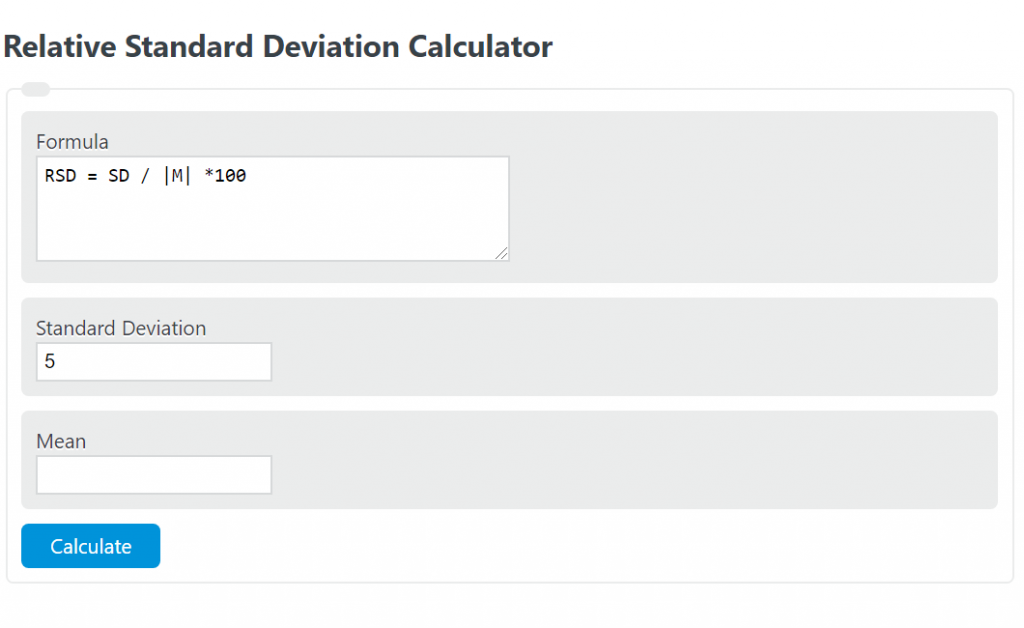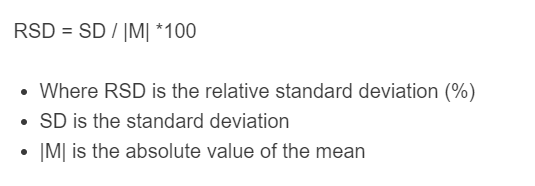Enter the mean and standard deviation of a data set into the calculator to determine the relative standard deviation.
- Standard Normal Distribution Calculator
- Empirical Rule Calculator (68%, 95%, 99.7%)
- Z-Score Calculator
- Coefficient of Determination Calculator
Relative Standard Deviation Formula
The following equation is used to calculate the relative standard deviation of a given data set.
RSD = SD / |M| *100
- Where RSD is the relative standard deviation (%)
- SD is the standard deviation
- |M| is the absolute value of the mean
Relative Standard Deviation Definition
Relative standard deviation (RSD) is a statistical measure used to express the variability or dispersion of a data set relative to its mean. It is a dimensionless quantity expressed as a percentage and enables comparison of the variability between different data sets or populations.
RSD is calculated by dividing the standard deviation of a data set by its mean and multiplying the result by 100 to obtain a percentage. This measure allows for comparing the dispersion of data sets with different units or scales, making it a useful tool in various fields such as finance, engineering, and scientific research.
By utilizing RSD, researchers and analysts can assess the consistency and reliability of data sets. A low RSD indicates that the values in the data set are closely clustered around the mean, suggesting a higher level of precision and reliability. Conversely, a high RSD signifies a greater spread of values, indicating greater variability and less precision in the data.
The importance of RSD lies in its ability to provide a standardized measure of dispersion, allowing for meaningful comparisons between different data sets. It is particularly valuable when dealing with data sets of varying scales, where comparing the absolute standard deviations might be misleading due to the different units involved.
RSD enables researchers to identify and quantify the extent of variability within a data set, which is crucial for decision-making and drawing meaningful conclusions. It helps determine the consistency and repeatability of measurements, aiding in quality control processes and assessing the reliability of experimental results.
RSD plays a vital role in risk assessment and management. In finance, for example, it is used to measure the volatility of investments. A higher RSD indicates greater market risk and potential fluctuations in investment returns. By considering the RSD, investors can evaluate the risk associated with different investment options and make informed decisions accordingly.
Relative Standard Deviation Example
How to calculate relative standard deviation
- First, determine the standard deviation
Calculate the standard deviation of the data set.
- Next determine the mean of the data set
The calculator will use the absolute value of this mean for the calculation.
- Finally, calculate the relative standard deviation
Enter the information from steps 1 and 2 into the calculator to determine the relative standard deviation.
FAQ
What is the significance of using the absolute value of the mean in the RSD calculation?
The absolute value of the mean is used in the RSD calculation to ensure the result is a non-negative percentage. This allows for a consistent and meaningful comparison of variability across different data sets, regardless of their mean’s sign.
How does RSD differ from standard deviation?
While standard deviation measures the amount of variability or dispersion from the mean in a data set, RSD expresses this variability as a percentage of the mean. This makes RSD a dimensionless quantity, allowing for comparisons between data sets with different units or scales.
Why is RSD considered a useful tool in finance and investment analysis?
RSD is particularly valuable in finance as it measures the volatility or risk associated with an investment. A higher RSD indicates greater variability in investment returns, helping investors assess the risk level of different investment options and make informed decisions.
Can RSD be applied to any type of data set?
Yes, RSD can be applied to any data set where the mean and standard deviation are defined and meaningful. It is a versatile tool used across various fields, including science, engineering, finance, and research, to compare the variability of different data sets or populations.

